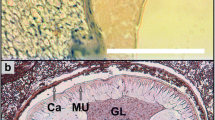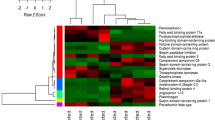Abstract
Three experiments have been carried out in vitro to determine the effect of oral and trans-tegumental uptake of clorsulon on the fine structure of the tegument and gut of Fasciola hepatica. Changes were assessed by transmission electron microscopy. In the first experiment, the flukes were ligatured to prevent the oral ingestion of drug and treated for 24 h in clorsulon (10 μg/ml). Limited swelling of the basal infolds was observed in the tegumental syncytium. Swollen mitochondria were present in the syncytium, the underlying tegumental cells and in the gastrodermal cells. Swelling and vesiculation of the cisternae of the granular endoplasmic reticulum (ger) was evident in the gastrodermal cells, together with a reduction in secretory activity. In the second experiment, flukes were fed for 24 h on red blood cells isolated from rats dosed with clorsulon at 12.5 mg/kg body weight; this experiment was designed to prevent the exposure of the tegumental surface to the drug. There was severe swelling of the basal infolds in the tegumental syncytium and swelling of mitochondria in the syncytium, tegumental cells and gastrodermal cells. In the tegumental cells there was a decrease in the number of Golgi complexes as well. A number of changes were evident in the gastrodermal cells: swelling of the ger cisternae, an increase in the number of autophagic vacuoles, a reduction in the number of secretory bodies and disruption of the lamellae projecting from the surface of the cells. In the third experiment, flukes were incubated for 24 h in clorsulon (10 μg/ml), with both absorptive surfaces being available for drug uptake. There was severe swelling of the basal infolds in the tegumental syncytium and large autophagic vacuoles were present. Swollen mitochondria were a feature of the tegument, tegumental cells and gastrodermal cells, as were swollen cisternae of ger in the tegumental and gastrodermal cells. Fewer Golgi complexes were observed in the tegumental cells and in the gastrodermal cells there were fewer secretory bodies and an increased number of autophagic vacuoles. Overall, the gastrodermal cells were more severely affected than the tegument. Greater disruption of the tegument occurred when the oral route of uptake was available. The results support those of previous studies which point to oral uptake of clorsulon being the major route of entry into the fluke.






Similar content being viewed by others
References
Anderson HR (1989) Studies on the mode of action of the fasciolicide diamphenethide (“Coriban”). PhD Thesis, The Queen’s University of Belfast, Belfast
Anderson HR, Fairweather I (1995) Fasciola hepatica: ultrastructural changes to the tegument of juvenile flukes following incubation in vitro with the deacetylated (amine) metabolite of diamphenethide. Int J Parasitol 25:319–333
Boray JC (1990) Drug resistance in Fasciola hepatica. In: Boray JC, Martin PJ, Roush RT (eds) Resistance of parasites to antiparasitic drugs. MSD AGVET, Rahway, N.J., pp 51–60
Buchanan JF, Fairweather I, Brennan GP, Trudgett A, Hoey EM (2003) Fasciola hepatica: surface and internal tegumental changes induced by treatment in vitro with the sulphoxide metabolite of albendazole (“Valbazen”). Parasitology 126:141–153
Fairweather I, Holmes SD, Threadgold LT (1984) Fasciola hepatica: motility response to fasciolicides in vitro. Exp Parasitol 57:209–224
Fairweather I, Anderson HR, Threadgold LT (1986) Fasciola hepatica: tegumental changes induced in vitro by the deacetylated (amine) metabolite of diamphenethide. Exp Parasitol 62:336–348
Kane HA, Behm CA, Bryant C (1980) Metabolic studies on the new fasciolicidal drug, closantel. Mol Biochem Parasitol 1:347–355
Malone JB, Ramsey RT, Loyacano AF (1984) Efficacy of clorsulon for treatment of mature naturally acquired and 8-week-old experimentally induced Fasciola hepatica infections in cattle. Am J Vet Res 45:851–854
Meaney M, Fairweather I, Brennan GP, McDowell LSL, Forbes AB (2003) Fasciola hepatica: effects of the fasciolicide clorsulon in vitro and in vivo on the tegumental surface, and a comparison of the effects on young- and old-mature flukes. Parasitol Res 91:238–250
Meaney M, Fairweather I, Brennan GP, Forbes AB (2004) Transmission electron microscope study of the ultrastructural changes induced in the tegument and gut of Fasciola hepatica following in vivo drug treatment with clorsulon. Parasitol Res 92:232–241
Meaney M, Haughey S, Brennan GP, Fairweather I (2005) A scanning electron microscope study on the route of entry of clorsulon into the liver fluke, Fasciola hepatica. Parasitol Res (in press)
Ostlind DA, Campbell WC, Riek, RF, Baylis P, Cifelli S, Hartman, RK, Lang RK, Butler RW, Mrozik H, Bochis RJ, Eskola P, Matzuk A, Waksminski FS, Olen LE, Schwartzkopf G, Grodski A, Linn BO, Lusi A, Wu MT, Shunk CH, Peterson LH, Milkowski JD, Hoff DR, Kulsa P, Harmon RE (1977) The efficacy of 4-amino-6-trichloroethenyl-1,3-benzenedisulphonamide against liver fluke in sheep and cattle. Br Vet J 133:211–214
Richards RJ, Bowen FL, Essenwein F, Steiger RF, Buscher G (1990) The efficacy of triclabendazole and other anthelmintics against Fasciola hepatica in controlled studies in cattle. Vet Rec 126:213–216
Robinson G, Threadgold LT (1975) Electron microscope studies of Fasciola hepatica. XII. The fine structure of the gastrodermis. Exp Parasitol 37:20–36
Robinson MW, Trudgett A, Hoey EM, Fairweather I (2002) Triclabendazole-resistant Fasciola hepatica: β-tubulin and response to in vitro treatment with triclabendazole. Parasitology 124:325–338
Rohrer SP, Saz HJ, Nowak T (1986) 31P-NMR studies of the metabolism of the parasitic helminths Ascaris suum and Fasciola hepatica. Arch Biochem Biophys 248:200–209
Schulman MD, Valentino D (1980) Fasciola hepatica: effect of 4-amino-6-trichloroethen yl-1,3-benzenedisulfonamide on glycolysis in vitro. Exp Parasitol 49:206–215
Schulman MD, Valentino D (1982) Purification, characterization and inhibition by MK-401of Fasciola hepatica phosphoglyceromutase. Mol Biochem Parasitol 5:321–332
Schulman MD, Valentino D, Cifelli S, Lang R, Ostlind DA (1979) A pharmacokinetic basis for the efficacy of 4-amino-6-trichlororoethenyl-1,3-benzenedisulfonamide against Fasciola hepatica in the rat. J Parasitol 65: 555–561
Schulman MD, Valentino D, Cifelli S, Ostlind DA (1982a) Dose-dependent pharmacokinetics and efficacy of MK-401 against old, and young-mature infections of Fasciola hepatica in the rat. J Parasitol 68:603–608
Schulman MD, Ostlind DA, Valentino D (1982b) Mechanism of action of MK-401 against Fasciola hepatica: inhibition of phosphoglycerate kinase. Mol Biochem Parasitol 5:133–145
Skuce PJ, Fairweather I (1990) The effect of the hydrogen ionophore closantel upon the pharmacology and ultrastructure of the adult liver fluke Fasciola hepatica. Parasitol Res 76:241–250
Skuce PJ, Anderson HR, Fairweather I (1987) The interaction between the deacetylated (amine) metabolite of diamphenethide (DAMD) and cytochemically demonstrable Na+/K+-ATPase activity in the tegument of Fasciola hepatica. Parasitol Res 74:161–167
Stitt AW, Fairweather I (1994) The effect of the sulphoxide metabolite of triclabendazole (“Fasinex”) on the tegument of mature and immature stages of the liver fluke, Fasciola hepatica. Parasitology 108:555–567
Sundlof SF, Whitlock TW (1992) Clorsulon pharmacokinetics in sheep and goats following oral and intravenous administration. J Vet Pharmacol Ther 15:282–291
Verheyen A, Vanparijs O, Lauwers H, Thienpont D (1980) The influence of closantel administration to sheep on the ultrastructure of the adult liver fluke, Fasciola hepatica L. In: Van den Bossche H (ed) The host-invader interplay. Elsevier/North Holland, Amsterdam, pp 705–708
Walker SM, McKinstry B, Boray JC, Brennan GP, Trudgett A, Hoey EM, Fletcher H, Fairweather I (2004) Response of two isolates of Fasciola hepatica to treatment with triclabendazole in vivo and in vitro. Parasitol Res 94:427–438
Yazwinski TA, Kilgore RL, Presson BL, Williams ML, Fulton RK, Pote L, Greenway TE (1985) Efficacy of oral clorsulon in the treatment of Fasciola hepatica infections in calves. Am J Vet Res 46:163–164
Author information
Authors and Affiliations
Corresponding author
Rights and permissions
About this article
Cite this article
Meaney, M., Haughey, S., Brennan, G.P. et al. Ultrastructural observations on oral ingestion and trans-tegumental uptake of clorsulon by the liver fluke, Fasciola hepatica. Parasitol Res 95, 201–212 (2005). https://doi.org/10.1007/s00436-004-1272-8
Received:
Accepted:
Published:
Issue Date:
DOI: https://doi.org/10.1007/s00436-004-1272-8




